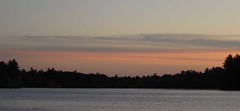
(Click for big.) Wow, nature. Now you're just showing off.
It's occurred to me that late October has been an incredibly busy time of year for me, so I can't guarantee you'll be seeing any Halloween content here (I suggest X-Entertainment if you need a fix). I can make a tentative promise however: Christmas content, I will have.
Until then, did anyone else amass an almost-complete collection of Peterson First Guides as a nerdy teen?

No? Just me? *sigh*
Well, anyway. the Peterson First Guides series was first published in the mid 1980's and as you can see, I managed to collect almost all of them. (A quick look online reveals that I only missed out on Forests. And a fair number of the guides I do have are long out of print.) I mentioned them very briefly before and I think I noted that I loved some of them to death.

No, I didn't yet carry a Sketchbook with me everywhere. I have no idea what any of those margin notes mean either. This was the first color field guide to birds I owned and nobody told me what to do/what NOT to do with it.
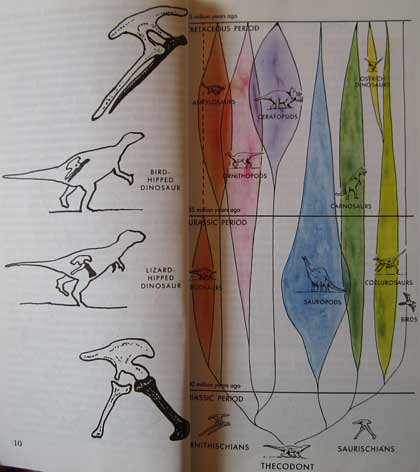
Anyway, the reason why we are here today is because of one of the most unusual titles in the series: Dinosaurs, written by John C. Kricher and illustrated by Gordon Morrison, published by Houghton Mifflin in 1990. This slim volume was once the best book on dinosaurs I owned. Digging it out of the big bookcase today, it turns out to be an unintentional treasure trove of paleoart memes from the era (see the dubious dinosaur family tree above. Why the "Ostrich Dinosaurs" are singled out, I have no idea.) As usual, most of the illustrations look very strange today. However, this book uses Peterson's trademark "look for this in the field" arrows, just like in any other of his Guides, so those paleoart memes are handily pointed out for us.
Funny Aneurysm Moment: In the introduction to this book, Roger Tory Peterson, the king of birdwatching, sadly notes that, "Of course, you are not going to see a dinosaur in the field". Damn, dude, nobody told him?
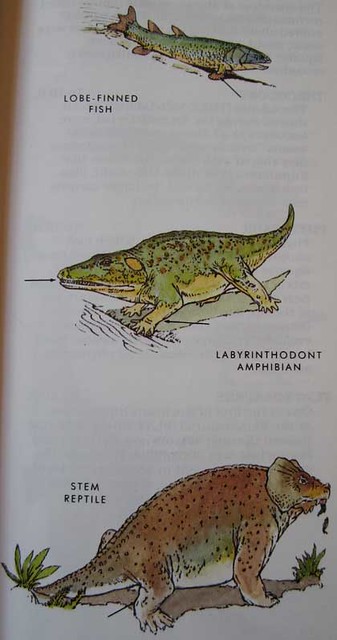
Most Peterson First Guides were illustrated with beautiful, almost photo-realistic paintings. Here, as you can see above, the illustrations look comparatively cheap. They also tend to be small and rather smudgy. It feels as though the illustrator thought the idea of a field guide to extinct species was silly and tried to get the assignment overwith as soon as possible.
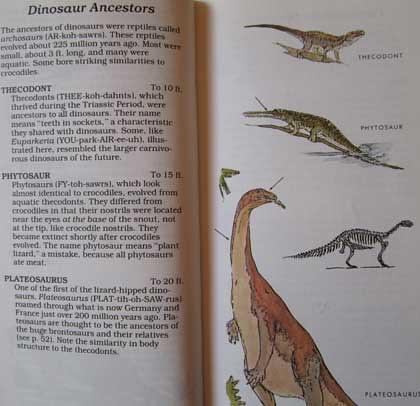
More classification brain-farts. Here, we've got poor Plateosaurus lumped in with "Dinosaur Ancestors" like Thecodonts. Uh?

A whole pack of strange Coelophysises-sess-esssssththth-(raspberry)... (Sorry.) Is it me or do all the background Coelos have the exact same face?
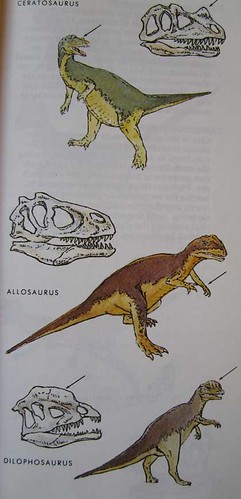
I love this page so much. So we've got a big, burly Ceratosaurus with just one rhino-style horn and a *really* short tail, a big, burly Dilophosaurus, and the only thing distinguishing Allosaurus is the fact that he's got three fingers. And, of course, bunny-hands for everyone!

In the 1990's, the world learned of the tragedy of eating disorders and obsessive body modification in young Carnotaurii.
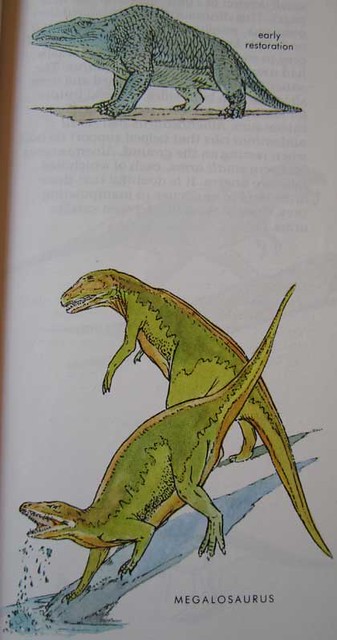
The paleoart memes here are subtle, but they show up a couple of times in the book as we shall see. Megalosaurus and Iguanodon are the only animals for whom the original reconstruction is shown. More interestingly, one of the Megs here is shown drinking from a pond. Anyone else reminded of the river raft scene in Jurassic Park?
Incidentally, Jurassic Park had it's first publication in 1990 and haunts this book like crazy. More on that in a bit.
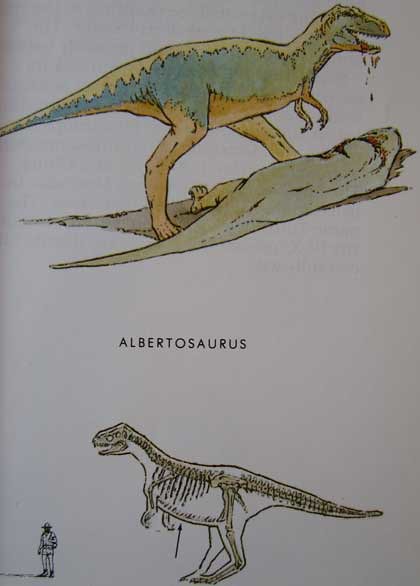
I rather like the color scheme on this Albertosaurus, but I really love the dopy skeletal study. The Scale Guy standing next to it is totally thinking, "whut?"
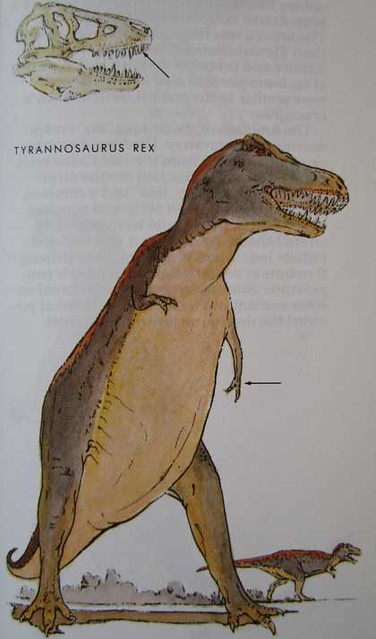
A man-in-suit Tyrannosaurus. A man-in-suit Tyrannosaurus drawn in 1990. A man-in-suit Tyrannosaurus drawn in 1990 with a relatively more correctly postured Tyrannosaurus as a smudgy little sketch in the background. Early 90's paleoart, ladies and gents.
Hey, did somebody order an 80's Spinosaurus who has just thrown his spine out?
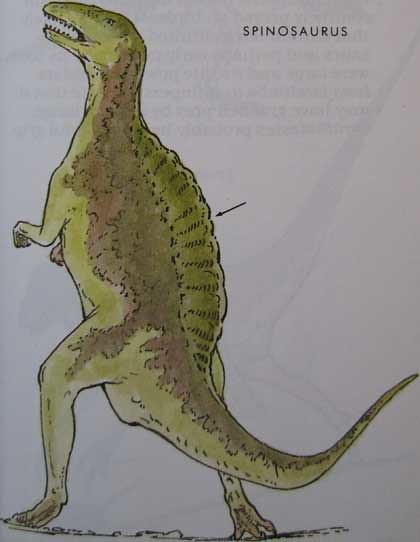 "OW!"
"OW!"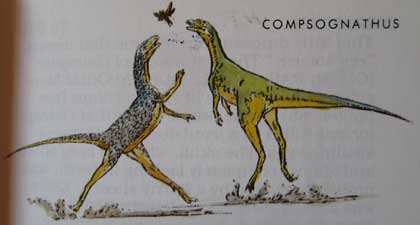
Now at this time, big theropods were Big Theropods and little theropods were Little Theropods, so it's time for Little Theropods. Here we've got an odd reconstruction of Compsognathus, one of whom is naked and one of whom has feathers, as "some scientists believe" according to the text.
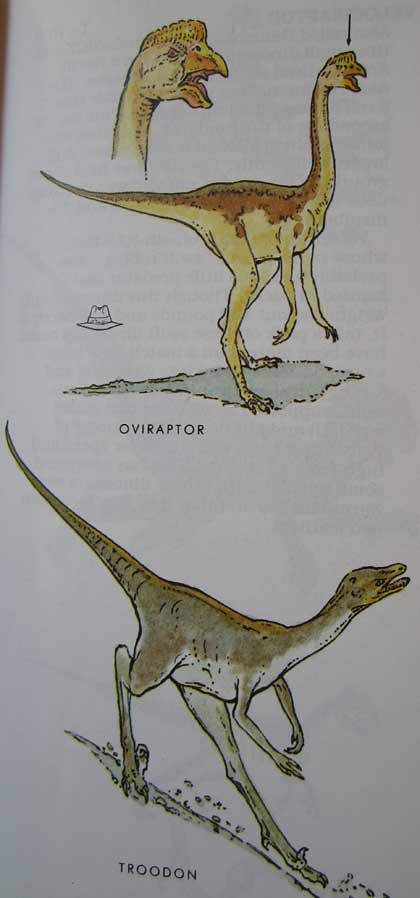
An Oviraptor-Skeksis sharing a page with a somewhat awkward-looking Troodon, which naturally brings us to...
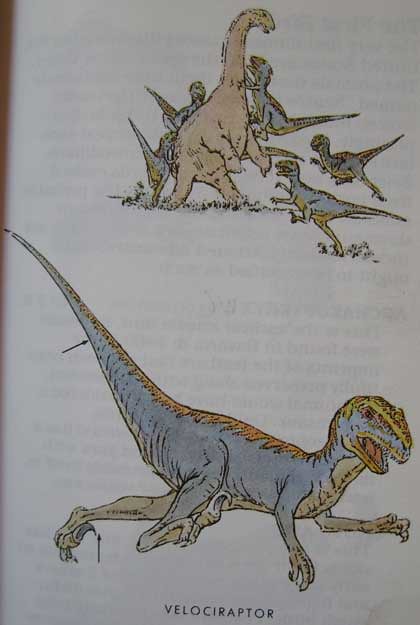
Oh, where to begin?
Okay, first off: the Great Dromeosaur Nomenclature Mess-Up of the late-80's-early-90's. Most of you already know about this, but the story's worth repeating, as it has caused more than it's fair share of headaches. Here's what I know:
In the good ol' Harvard Museum of Natural History, there is a very old mount of a maniraptor about the same size as the Jurassic Park (book and film) raptors, and it is labeled "Deinonychus". Now it turns out that the mount has a few significant things wrong with it: it has the wrong head mounted on it and the hands are in the "kangaroo/bunny hand" position instead of the correct "killer buffalo wings" position. Nonetheless, this is what most people imagine when they hear "Deinonychus".
In Predatory Dinosaurs of the World, Gregory S. Paul suggested consolidating several genre of closely-related theropods into one genre. In other words, all the very similar looking "Ostrich mimics" like Gallimimus, Struthiomimus, ect. are listed instead as Ornithomimus sp. And almost all then-known dromeosaurs (aside from Dromeosaurus itself) went under the Velociraptor sp. umbrella, probably because it's just the cooler name (or was named first, whatever). Deinonychus is called Velociraptor antirrhopus in the book.
Still with me? Good, cause this is more involved then I expected. Michael Crichton uses Paul's book when researching Jurassic Park and carries the Velociraptor antirrhopus thing along with him. He also makes his raptors somewhat bigger, meaner, and a LOT weirder. (Chameleon abilities! They can gnaw through steel bars! Corrosive saliva! They can *swim*! Man, one of these days, I need to do a "Things in Jurassic Park that are Weird As Hell Today" post.)
Naturally, the Velociraptor antirrhopus thing carries over into the film, though it's raptors are even *bigger*. (I still fail to understand why a turkey-sized animal with large talons ripping your lungs out isn't as scary as a pony-sized animal doing the same things.) By a happy coincidence, Utahraptor was discovered around the same time and the crowd went wild.
Point is, that's why this very typical 80's Deinonychus is identified as Velociraptor.
Bonus: A whole pack of 'raptors attacking a comparatively huge... something. (I assume that's supposed to be a Tenontosaurus, but it looks a whole awful lot like a badly-drawn sauropod.)
Bonus Bonus: Naked Sparkleraptor.

On that note, I think I'm going to pause here because this is running very long. Here we've got a very 80's Archaeopteryx and "Proto-Avis", a "hypothetical animal, one that has not actually been found yet." "Proto-Avis" is what people in the 80's expected a close relative of Archaeopteryx to look like. Note that it looks less like a feathered dinosaur and more like a weird lizard-thing with feathers. Dat tongue...
Next time, childhood trauma, chill Chasmosaurs, and the 80's equivalent of the nautical nonsense that's been making the paleo-blogosphere rounds lately.
-----
Art of the day!
I started in on this:

